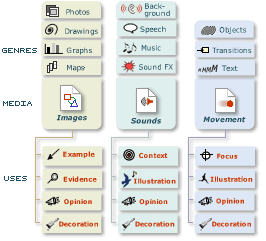How Media Can Be Used
To Support An Argument
In a persuasive text, the author is trying to make a case, to present an argument for a particular idea. Each kind of Medium can be used to support that argument in at least fo ur different ways:
 Example ( Images )
Example ( Images )
Images are most frequently used as examples. In that case, the new information is in the context rather in the image itself, in the category of things, event or people it represents. So the word "Traffic" is accompanied by a photograph of a stream of cars on a highway. This image is just one example of traffic - there could be many others, but it clarifies the meaning of the word by turning it into "the flow of vehicles" rather than "transporting goods".
 Evidence ( Images )
Evidence ( Images )
When an image is used as evidence, it provides new information, not contained in the text on the screen - and the information is inside the image, is what the image shows. For an image to work as evidence, it must be a self-contained piece of information, capable of supporting one’s argument in a unique way. So the words “We are meeting our goals” supported by a picture of smiling employees would not be an example of an image used as evidence – those people could be smiling for any number of reasons; but the words "We are meeting our goals" accompanied by a graph showing the increase in value over time IS an example of evidence – the graph itself adds new information that supports the argument.
 Opinion ( Images/Sounds/Movement )
Opinion ( Images/Sounds/Movement )
Images, sounds and movement can also be used to cast the text in a specific light - to express an opinion, a feeling or an attitude toward the meaning of the text. So the words "Join the Army" are juxtaposed with an image of a bedraggled-looking bunch of soldiers, there is the sound of gunfire and a hand grenade lobs into the center of the screen from outside the frame. Clearly, the media effects are used to express opposition to the notion of enrolling in the armed forces.
 Decoration ( Images/Sounds/Movement )
Decoration ( Images/Sounds/Movement )
The simplest way to use images, sounds and movement is to decorate a slide. The information on the slide is carried by the text and the "effects" serve to enliven and embellish - not to add information. So a slide about Paris has an image of the Eiffel tower, plays an accordion sound and the letters in the word "PARIS" twinkle and wave. There is no new information in any of the media bits that the text alone does not convey.
 Illustration ( Images/Sounds/Movement )
Illustration ( Images/Sounds/Movement )
Sounds and movement can also be used to illustrate something happening in a picture. They can add information about something happening IN the image. The sound of a car motor, for instance, illustrates what is happening in a picture of an automobile: it is driving. The movement of the window wipers, on the other hand, can add information about the weather conditions in which the car is driving.
 Context ( Sounds )
Context ( Sounds )
Sounds can be used to provide context by providing information about something not visible in an image, something outside the frame of the picture. So a picture of a flowering bush has a very different meaning if it is accompanied by the sounds of urban traffic or by a babbling brook. The sound produces additional information because it puts the picture into an environment
 Focus ( Movement )
Focus ( Movement )
Movement can be used to focus the viewer's attention on a part of the screen. The movement of objects or words adds information by calling attention to a central part of the image. A picture of a beach scene on which a beach ball bounces between two children, for instance, puts the children into the center of the viewer's attention, rather than the waves of the ocean or the sounds of hot dog vendors.
